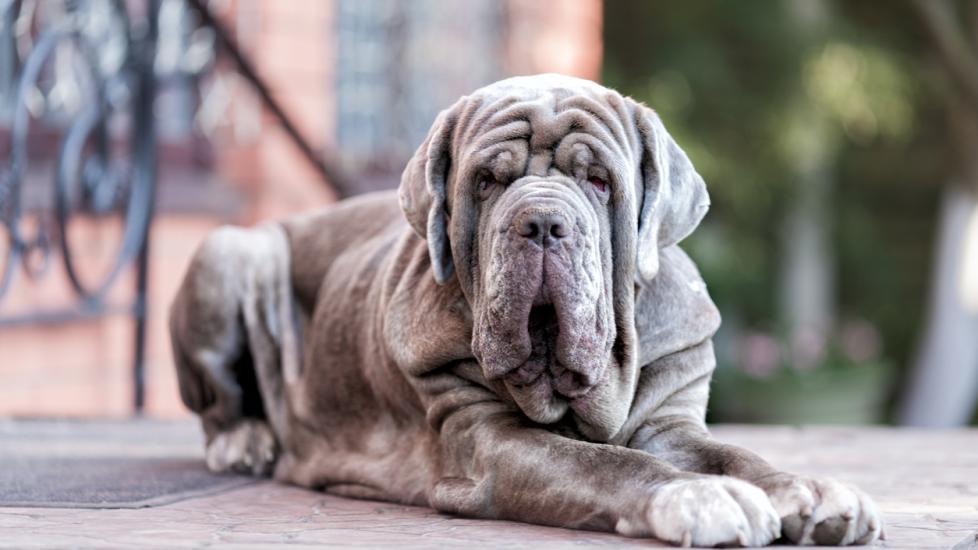Neapolitan Mastiff
iStock/Salima Senyavskaya
Large and powerful Neapolitan Mastiffs have long been protectors: first as dogs of war used by the ancient Roman army, then as estate guard dogs in Italy, and now as honorary guardians of your couch. Though Neapolitan Mastiffs once fought lions, elephants, and men in battle, today they are happiest staying at home. Don’t let the Neapolitan Mastiff’s size fool you—this breed is a gentle giant.
According to the United States Neapolitan Mastiff Club (USNMC), these droopy, wrinkly dogs were bred to be “ugly” on purpose to deter any unwanted intruders. But that hasn’t stopped them from being movie stars: Most notably, a Neapolitan Mastiff named Hugo played Hagrid’s dog, Fang, in the Harry Potter films.
Caring for a Neapolitan Mastiff
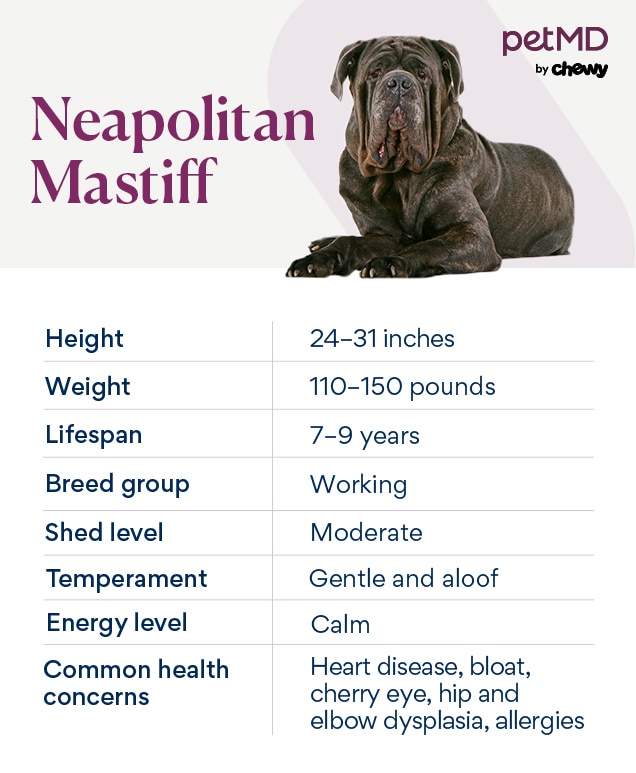
Neapolitan Mastiffs are huge, weighing in at 110–150 pounds and standing 24–31 inches tall. Neapolitan Mastiffs are great with families and children, but they can be wary of strangers and may not get along with other pets. These lumbering, large dogs are equally lazy and loyal.
Neapolitan Mastiff Health Issues
The Neapolitan Mastiff lifespan is just 7–9 years, much shorter than the average dog’s life. This short lifespan is because of their massive size and their propensity for health issues. Before bringing home a Neapolitan Mastiff puppy, consider investing in pet insurance so you can keep this giant breed healthy.
Heart Disease
Neapolitan Mastiffs are prone to cardiac conditions, including dilated cardiomyopathy. Mastiffs with dilated cardiomyopathy will sometimes have an irregular heartbeat, or heart murmur, that your vet can hear during an exam. A definitive diagnosis will come after an echocardiogram, or ultrasound of your dog’s heart. DCM causes the heart muscle to thicken and cause symptoms including:
-
Irregular breathing
-
Weakness
-
Depression
-
Sudden death
“The earlier the condition is identified, the easier it is to manage,” says Joanna Woodnutt, DVM. She says dilated cardiomyopathy has a genetic component, so it’s a good idea to get a Neapolitan Mastiff puppy from a breeder who screens their dogs before breeding them to ensure you’re getting a healthy pup.
Allergies
Neapolitan Mastiffs have lots of skin folds that are prone to irritation, often secondary to developing skin allergies. This breed may also be susceptible to ear infections secondary to allergies or have seasonal allergies. Talk to your veterinarian about how to best manage your dog’s allergies. Treatment may include regular baths with medicated shampoo, cleaning your pup with a medicated wipe, and keeping up with vet appointments.
Gastric Dilatation and Volvulus (GDV)
Large- and giant-breed dogs, such as Neapolitan Mastiffs, are prone to a condition called gastric dilatation and volvulus, a severe form of bloat in dogs. This is a life-threatening condition where a dog’s stomach fills with gas and twists. Signs that a dog is experiencing bloat include:
-
Retching without vomiting
-
Inability to settle
-
Distended abdomen
If you notice any of these symptoms, contact your vet immediately or take your dog to the nearest emergency vet.
Hip and Elbow Dysplasia
Neapolitan Mastiffs are prone to hip dysplasia and elbow dysplasia. This is when the joint (either the hip or elbow joint) develops improperly and doesn’t fit together as it should. Large and giant dog breeds commonly deal with these conditions. Excessive or rapid growth, exercise, and weight gain can all contribute to hip and elbow dysplasia, though it’s also hereditary.
“Dysplasia can affect the dog’s mobility and can lead to painful movement, an uneven gait, and struggling to sit, stand, and climb,” says Woodnutt. “Slippery floors and stairs are a big no-no until your dog is fully grown at a couple of years old.”
Dogs with hip dysplasia may need to lose weight, have limited exercise on hard surfaces, and participate in physical therapy. More severe cases may require surgery. If left untreated, hip and elbow dysplasia will lead to arthritis.
Cherry Eye
Cherry eye is a condition many Neapolitan Mastiffs inherit. With a cherry eye, a Neapolitan’s third eyelid has protruded to cover part of an eye, obstructing their view. Cherry eye in dogs typically looks like a pink triangle in the corner of the eye. Surgery is recommended to correct this issue.
What To Feed a Neapolitan Mastiff
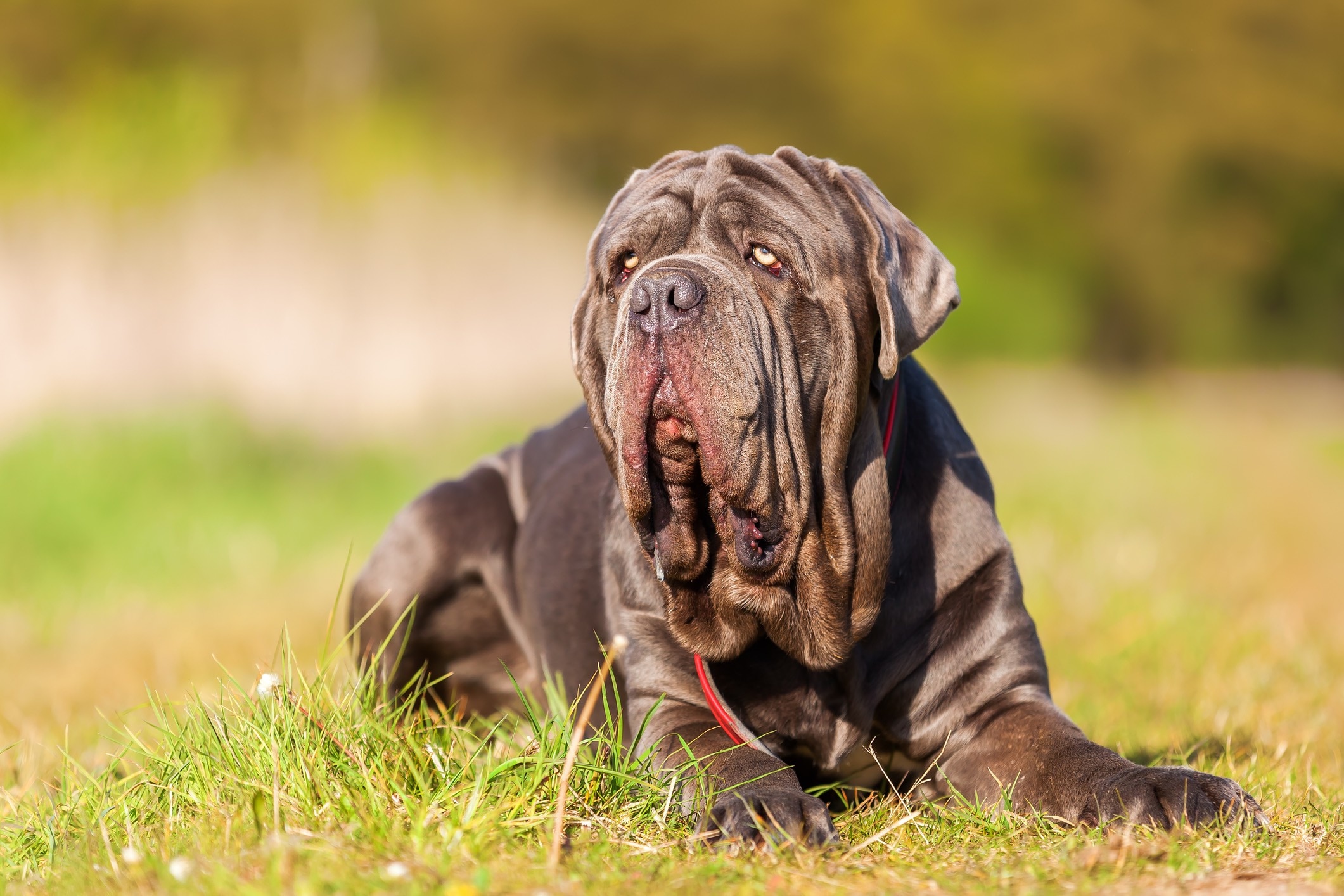
Neapolitan Mastiffs need regular meals of dog food approved by the Association of American Feed Control Officials (AAFCO). They may also benefit from omega-3 supplements.
Because the Neapolitan Mastiff is a giant dog, they should eat a diet specifically for large or giant breeds—especially as puppies. These diets have special ingredients, such as joint supplements, and a lower calcium level than regular dog food, which is essential for proper growth.
How To Feed a Neapolitan Mastiff
Adults should eat two meals per day, while Neapolitan Mastiff puppies should eat three or four meals every day on a regular schedule. Do not free-feed your Neapolitan Mastiff; leaving out a bowl of dog food all day can cause dogs to overeat, leading to obesity.
If your Neapolitan Mastiff dog snarfs up their food too fast, reduce their pace by introducing a slow-feeding bowl. And because Neapolitan Mastiffs can develop bloat, always feed them from a bowl on the floor, not from an elevated bowl.
How Much Should You Feed a Neapolitan Mastiff?
How much to feed your Neapolitan Mastiff depends on your specific dog’s health, weight, activity level, size, and other factors. Generally speaking, you should follow the instructions on your dog food bag for portion sizes. But every Neapolitan Mastiff has different nutritional needs, and you should consult your veterinarian if you’re unsure of how much to feed them.
Nutritional Tips for Neapolitan Mastiffs
A Neapolitan Mastiff that eats a balanced diet shouldn’t need supplements to stay healthy. However, adding omega-3 supplements, such as fish oil, to your dog’s diet may help keep all that loose skin healthy. Joint supplements are also a great idea to promote joint health in your Neapolitan. Your veterinarian can provide advice on nutritional supplements to give your Neapolitan Mastiff, if needed.
Behavior and Training Tips for Neapolitan Mastiffs
Neapolitan Mastiff Personality and Temperament

Neapolitan Mastiffs are homebodies. They enjoy the occasional walk, but they are more than happy to lie around the house all day and get most of their activity by roaming around the backyard. Because Neapolitan Mastiffs can be lazy, pet parents need to exercise these big dogs regularly and engage them in mentally stimulating games.
The Neapolitan Mastiff has a long history of acting as a guardian, so expect them to be loyal to your family and watchful over your household. However, a Neapolitan Mastiff’s unending love for family won’t be extended to strangers initially, so expect them to be reserved around new people. Proper socialization and positive-reinforcement training from an early age will help your dog be welcoming of new people, animals, and situations.
Neapolitan Mastiff Behavior
Neapolitan Mastiffs are almost feline-like in their behavior; they will very happily spend the day lying around and napping in the sun. And while their large size and “ugly” appearance were historically designed to ward off people, these dogs are sweethearts. Just make sure to socialize your Neapolitan Mastiff puppy early and consistently so they don’t grow to be aloof around people they don’t know.
Neapolitan Mastiff Training
Training a Neapolitan Mastiff must start at a young age. These dogs were bred to work independently, and that strong-willed nature can make training a real practice in patience. Always use positive-reinforcement training methods with lots of praise and treats; try healthy treat options like chopped carrots and apple slices to avoid weight gain.
“Training the Neapolitan Mastiff is no easy feat, which is why we typically recommend that only experienced dog parents take this breed on,” says Woodnutt. “Training one of these dogs is a lifelong commitment, requiring a lot of dedication and patience.”
Fun Activities for Neapolitan Mastiffs
-
Walks (ideally multiple times a day)
-
Obedience training
-
Slow feeders
Neapolitan Mastiff Grooming Guide
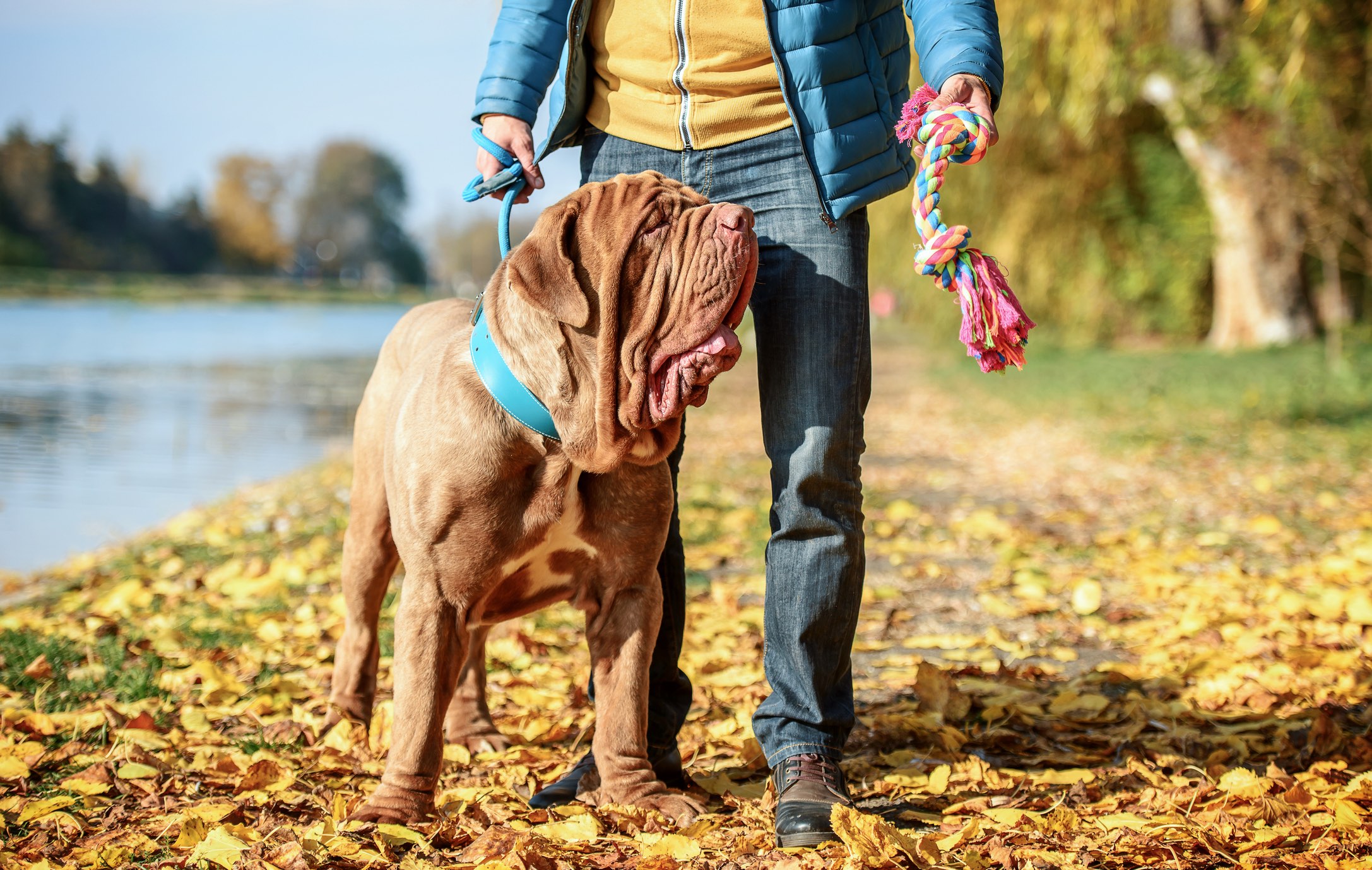
Neapolitan Mastiffs must have their skin cleaned regularly so their wrinkles stay healthy. They also drool a lot, and pet parents must regularly wipe their dog’s face and in between skin folds with a cloth or wipe. But there is good news: Neapolitan Mastiffs don’t shed much, so you and your home won’t be covered in loose hairs.
Skin Care
The Neapolitan Mastiff has sensitive, oily skin and will need a bath once or twice a month, according to the USNMC. If your dog has been diagnosed with skin allergies, you’ll need to bathe them more frequently.
To make the bathing process easier, get your Neapolitan Mastiff used to frequent baths when they’re a puppy. Pet parents should also invest in bathing tools such as lick mats, dog shampoos, and coat conditioners.
Coat Care
Despite their short coat, the Neapolitan Mastiff breed needs to be gently brushed a few times each week—if you brush too harshly, you can damage their sensitive skin. Like many other dogs, Neapolitan Mastiffs shed more in the spring and fall, so they’ll need more frequent brushings during those seasons.
Eye Care
Because Neapolitan Mastiffs are prone to cherry eye, pet parents need to monitor their pup’s eyes to make sure they stay healthy. Talk with your veterinarian if you notice any changes in your dog’s eyes; they can guide you through important decisions about your Neapolitan Mastiff’s eye care.
Ear Care
Regularly check your Neapolitan Mastiff’s ears for lacerations, dirt, and excess wax. Clean their ears often with a dog-specific ear cleaner and, if you notice any changes, talk to your veterinarian.
Considerations for Pet Parents
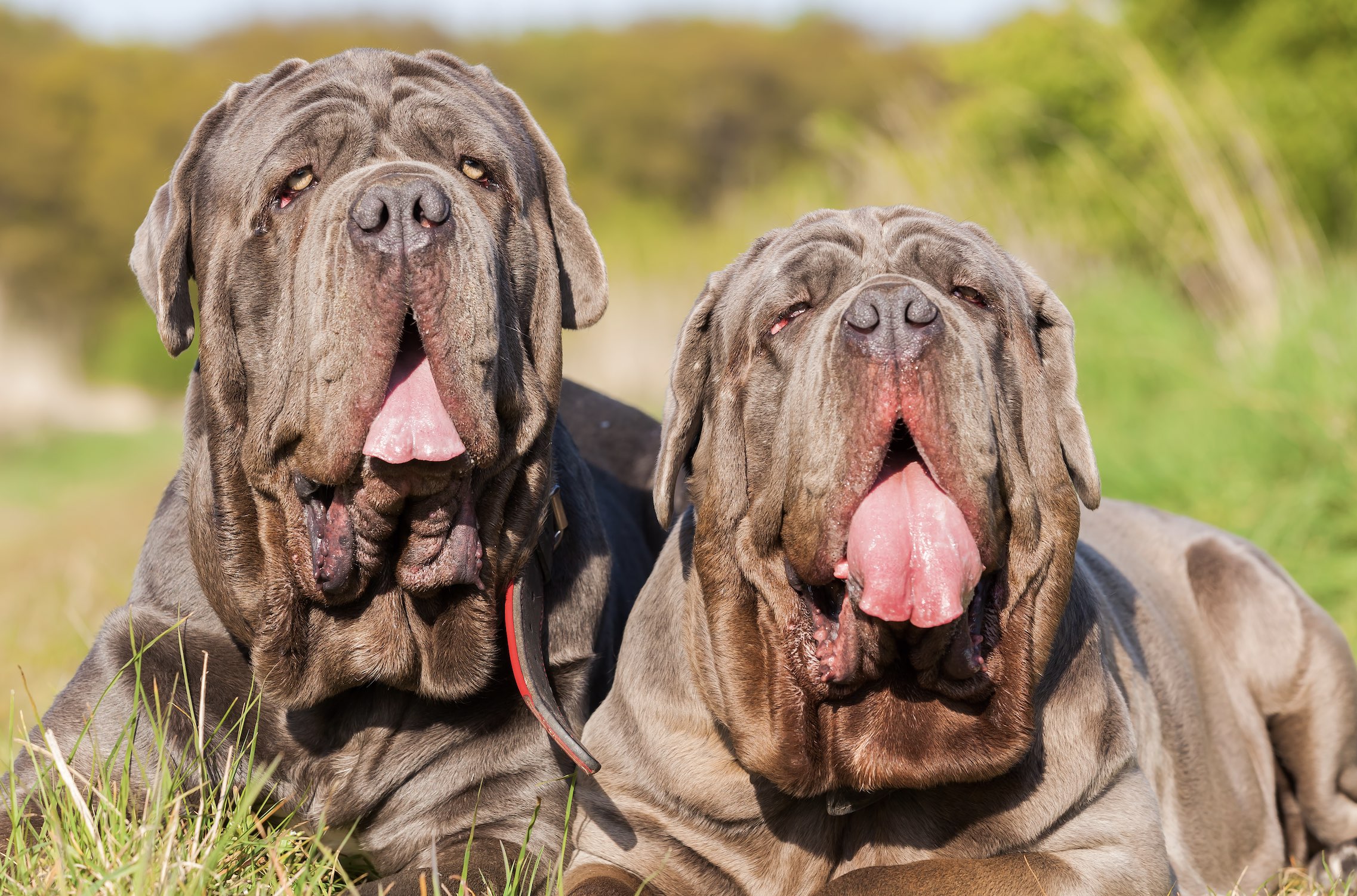
Neapolitan Mastiffs are large dogs and, though they can be lazy, need room to move around. If you live in an apartment, expect to walk your Neapolitan Mastiff multiple times a day and have space that is specifically for your canine companion, including a large orthopedic bed to cushion their joints. Neapolitan Mastiffs enjoy the outdoors but won’t want to be outside all day, so it’s OK if they don’t have their own backyard.
The Neapolitan Mastiff is prone to many health conditions. By adding a Neapolitan Mastiff to your family, you will be responsible for many veterinary visits, plus a high monthly budget for food—these pups eat a lot.
Neapolitan Mastiff FAQs
Is a Neapolitan Mastiff a good family dog?
A Neapolitan Mastiff makes an excellent family dog because they are intelligent, gentle, and affectionate. Neapolitan Mastiffs have a lot of love to share, but you shouldn’t leave one alone with a small child: The dog’s massive size means they can easily knock a child over or accidentally step on them.
How much does a Neapolitan Mastiff cost?
A purebred Neapolitan Mastiff puppy costs $3,500–$5,000, depending on their breeding.
Beyond the cost of adoption, a Neapolitan Mastiff needs a crate, collar, food, water bowl, regular veterinary checkups, and other pet supplies. You may also want to invest in pet insurance.
Is a Neapolitan Mastiff the same as a Cane Corso?
A Neapolitan Mastiff is not the same as a Cane Corso. The breeds are both Italian and resemble each other in color and size, but they are completely different breeds. There’s one easy way to tell the two apart: Neapolitan Mastiffs have folds in their skin, while Cane Corsi have tight, smooth skin.
